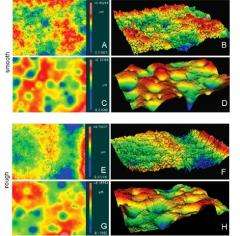December 9, 2010 feature
Scientists discover fractal pattern in Scotch tape

(PhysOrg.com) -- Clear cellophane tape – which can be found in almost every home in the industrialized world – may seem quite ordinary, but recent research has shown otherwise. In 2008, scientists discovered that, when peeled, Scotch tape produces X-rays that are strong enough to image the bones in a human finger. In a new study, scientists have further investigated what happens when clear tape is peeled, and found that the tape's surface roughness displays a fractal pattern. The findings may lead to a better understanding of the processes involved in peeling, the origin of the X-ray emission, and in the design of better tape that can be reused repeatedly.
The study’s authors, Bo Persson from FZ-Julich in Julich, Germany (who was also a coauthor of the X-ray study), Alexander Kovalev and Stanislav Gorb from the University of Kiel in Kiel, Germany, and Matthias Wasem and Enrico Gnecco from the University of Basel in Basel, Switzerland, have published their results in a recent issue of Europhysics Letters.
In their study, the scientists used a white-light interferometer as well as an atomic force microscope to look at the tape’s sticky surface after it had been peeled off a hard substrate. They found that slowly peeling the tape leaves behind a rough, white surface on the soft rubber adhesive layer (the white color is due to the large light scattering from the rough surface). On the other hand, peeling the tape more quickly leaves behind a smoother, transparent surface (transparent because there is less light scattering from the smoother surface).
In addition, the scientists were surprised to find that both the rough and smooth surfaces exhibited fractal scaling properties over a wide range of length scales, with a fractal dimension that is typical for surfaces produced by crack propagation. The scientists did not expect this result because of the influence of the surface free energy. That is, elastically soft solids such as the tacky rubber adhesive should deform at short length scales in order to reduce the surface free energy. This should result in a much smoother surface at short length scales (or high magnification) than would otherwise be expected. This effect had already been observed in a different context, but could not be detected on the rubber film of the peeled tape.

The findings could help scientists better understand the cause of the X-rays generated from peeled tape, which is thought to be associated with the surface roughness of the tape. Information about the tape’s surface roughness could also be used to explain the maximum emitted photon energy of the tape.
The scientists also suggested that, by understanding the tape’s surface roughness after peeling, manufacturers could build in a specific roughness during the production process that could stabilize the adhesion, resulting in tape that can be used multiple times without losing its adhesive properties.
More information: B. N. J. Persson, et al. “Surface roughness of peeled adhesive tape: A mystery?” Europhysics Letters, 92 (2010) 46001. DOI: 1209/0295-5075/92/46001
Copyright 2010 PhysOrg.com.
All rights reserved. This material may not be published, broadcast, rewritten or redistributed in whole or part without the express written permission of PhysOrg.com.


















